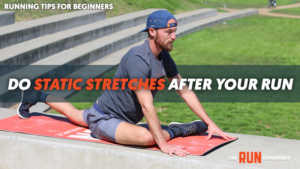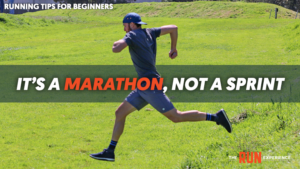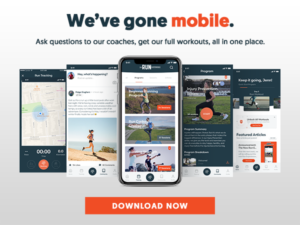10 Things to Tell Your Friend Who Just Started Running

Runners are everywhere now that we’re in quarantine. After all, running is one of only a few social-distancing-friendly activities. Personally, I love seeing so many people getting active.
This also means that there are many new runners out there. People who normally go to the gym need a new outlet; people who didn’t use to work out are bored enough to give it a go; many who have always wanted to give running a try finally have the time.
If you have a friend or family member who just started running and is hoping to avoid any newbie mistakes, here are some must-read running tips for beginners that you can share.
The Best Running Tips for Beginners
1. Build mileage gradually
We get it: a new runner is eager to get started and make running a habit. While this is great, too often beginner runners will run too much mileage their first couple of weeks, only to deal with overuse problems or exhaustion a few weeks later.
To avoid injuries and burnout, tell your friend to build mileage gradually, starting with around 2 miles each run for three days a week and one long run a week. Total weekly mileage shouldn’t increase by more than 10% each week.
So, for example, if a runner starts at 9 or 10 miles per week, the next week they should increase to 10 or 11 miles. The 10% rule isn’t a perfect rule, especially for runners starting from scratch, but it’s generally a good guideline for building mileage at a safe pace.
Check out our 30-day beginner running plan to get the best training plan for you.
2. Go for time rather than distance

New runners often struggle with pace-setting, starting out too fast only to have to slow down by the end of their run. To make pace-setting easier, beginner runners should run for time rather than distance to avoid “racing” their runs.
While running for distance or time are both fine ways to train, running for time can be mentally helpful for beginners. Since most races are about how fast you can cover a certain distance, it’s easy to bring this “PR” mentality to our easy runs and workouts and run way too fast. When we run for time, a 30-minute run is the same no matter our speed, allowing the focus to be on effort rather than pace per mile.
As a new runner, the main goal is to build up your aerobic base, which requires running longer at an easy, maintainable pace. By using minutes and not miles as the measuring stick, we can ease into a run with a jog and run based on how we feel, not about covering a specific distance.
Coach Holly has some great pacing tips for beginner runners here:
3. Don’t be afraid of walk breaks!
Walk breaks can make a huge difference to new runners’ longevity. Instead of trying to run for 30-minutes straight, break up the run into running and walking segments. This will help you aerobically, but also mentally.
Especially if you are running on a treadmill, it can be tough to stay focused mentally. A great tip for beginner runners is to incorporate regular walk breaks when first starting.
Walk breaks also help lighten the total impact of a run. If the goal is to train for a half-marathon or marathon, the run-walk-run method is a great way to build up for those longer distances. Sure, you’ll lose the walk breaks eventually, but your body will be ready for the sustained impact once you get there.
Use walk breaks to break up longer runs and bring your heart rate down between run segments. As a starting point, try running for anywhere from 2-5 minutes. Then, walk for one to two minutes. Repeat this cycle for the entire duration of your run, however long that is.
Learn how to create a walk-run routine here:
4. Warm-up and cool-down properly

We’ve all been there – you go out for a run, feel great, but then you can’t walk normally the next day. To prevent a “post-run hangover,” tell your running friends to incorporate time to warm-up before runs and stretch after.
Warm-ups and cool-downs not only reduce the risk of injury, but they also prime the body for movement. Especially for someone who is new to running, a warm-up is essential to activate the right parts of the body, from the shoulders to the feet.
If your friend has been sitting around at home a lot (I know I have!) tell them to activate their glutes with some glute bridges, donkey kicks, or squats before heading out.
Cool-downs are equally important to relax any muscles that might have tightened up during the run. They’ll also help prevent tight hip flexors and hamstrings, knee pain, improve your joint mobility, and reduce muscle soreness. All the things we need to keep us running longer and more often! Tell your friend to try this post-run stretch routine after their next run.
5. Invest in some running shoes

Running is great because it doesn’t take much equipment to get started. But, if there’s one piece of equipment a beginning runner should invest in, it’s a good pair of running shoes.
The right shoes shouldn’t pinch the toes, they should provide proper arch support, and, above all, they should be comfortable. Tell your friend to make sure their shoes have enough room in the toe-box and provide support for their ankles.
Consider sizing up in a running shoe. If you’re running on hills, your feet might move slightly forward or back as you ascend and descend. Give your feet some room to move! There is no golden rule for sizing; this is just something to consider.
Normally we’d suggest going to a running store to find the best running shoes, but, given coronavirus shopping conditions, advise your new runner to read blogs and reviews online to help decide on the best pair. Running Shoes Guru, Sole Review and Run Repeat all collect thousands of runner-approved reviews.
Coach Nate has all the details on what to look for in your first pair of running shoes:
6. Set realistic, achievable goals
Like tip one (build mileage gradually), beginner runners should set realistic goals that don’t push the body too far, too fast. If a new runner wants to run a marathon or ultramarathon, they definitely can!
But it won’t happen overnight, or even in three months. A newbie runner should first build up to running for at least an hour before they start a marathon training program, which should take at least a month or so to build up to.
A running coach or personal trainer (like our coaches on The Run Experience app!) can be a great resource to help your friend create goals and set up the right plan to achieve them.
For some pointers on training for a longer race like a marathon as a beginner, Coach Nate has 3 big tips:
7. Plan your runs
As with any new activity, having a plan will lead to faster results. If a newbie runner is only running sporadically, without keeping track of distances or holding consistency, it makes it harder to build up to longer runs and increase mileage.
Tell your friend to plan out runs for the week like anything else on their schedule, deciding how far they will run, where they will run, what time of day, and any other details that can be decided ahead of time. Plan down to the music playlist or podcast they plan to listen to. The less decision-making a run requires, the less mental willpower it takes to get out and actually…go run.
When new runners fall into a run routine with a detailed plan, they’re much more likely to follow through. Not sure where they should start? Tell them about our free 8-week beginner’s running plan for a guide.
8. Cross-Train

To become a better runner, should you do other things besides run? It may sound weird, but actually, a big mistake new runners make is only running and not doing any cross-training.
A major running tip for beginners: regularly incorporate mobility sessions and stretching from day one. This will help prevent common running ailments like shin splints, IT band pain, and sore calves. Once or twice a week runners should also do some kind of strength training to improve overall fitness and improve bone and muscular strength.
A good cross-training schedule for beginner runners is to do mobility and drills once a week, pick another day or two for strength-training moves like push-ups, lunges, squats and core work, and then take at least one rest day. If needed, swap out a running day for cycling or the elliptical.
Here’s a video with Coach Holly showing you some key running form drills:
9. Test Out Your Pre and Post Run Food
A beginner runner will learn that sometimes running after eating certain foods does weird things to the stomach. It’s a lesson most runners deal with at some point, but with these tips, a beginner runner can try to avoid them!
For shorter runs, regular meals and snacks will likely be enough fuel. On runs longer than an hour, tell them to test out eating different simple carbohydrates at least an hour before their run.
Some snack ideas:
- Banana with honey
- Bag of pretzels
- Small box of raisins
- Half a bagel with butter or peanut butter
For more, listen to Coach Elizabeth’s tips for beginner runners on fueling for long runs here.
After runs, advise your friend to refuel with a light snack focused on complex carbs and protein. This could be a meal of salmon and sweet potato fries, a snack of nutty trail mix, or a spinach and cheese omelet.
On The Run Experience mobile app, our Healthy Habits four-week course helps users lay the groundwork to eating more nutritious meals with simple habits and a framework to follow for healthy eating.
10. Ditch your ego

You may have picked up on a theme in this article about the best running tips for beginners. Mainly, it’s start slow, run easy, and avoid running too fast or long when you’re just starting.
One of the quickest ways to get injured as a runner is by overloading the body with too much mileage and speed before it’s ready. And if you don’t get injured, you still might experience burnout. That’s why it’s so important to approach a new running routine with a balanced schedule and incorporate stretching and strength training.
There’s no shame in going slow and gradually building up your endurance. In fact, you’ll see much better results that way. Advise your friend to give themselves enough time to train before signing up for a longer race.
If you or your friend is looking for running tips for beginners or other levels, download our mobile app for in-depth programs, information and an amazing virtual community that can connect you with an online running group.

